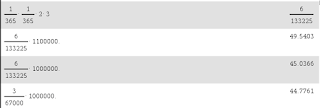In particular I highlighted the number of steps: 2 408 434!!!
I was curious to hear what they thought of this screen. It didn't take long to get the response I was hoping to hear...how far is that?!?!? I really didn't want an abstract answer of so many kilometres but preferred to know something we could all relate to. Could I have walked to downtown Toronto? How about Montreal?
Here is what one group determined.
I was curious to see what strategy the students would use to determine the number of steps per kilometre. I had brought in tape measures thinking they may want to measure a typical walking gate but no one ended up using them. This group was typical of the approach that each group used - they searched the number of steps online.
I spent some time after class mapping the different locations that each group derived. Here is the map.
My personal favourite appealed to my love of the Red Sox - I can walk to and from Boston. They were even kind enough to tell me how long it would take me - 7 days 9 hours....one way.
I'm not sure where this activity goes from here. I recorded the solutions for all of the groups and was thinking to share them with the class so we can discuss the strategies and whether all of the locations seem reasonable for the distance calculated. Maybe the experience of seeing so much math in a simple number that led to an engaging exploration that addressed the key expectations in 9 Applied of rate of change and proportional reasoning is good enough.













